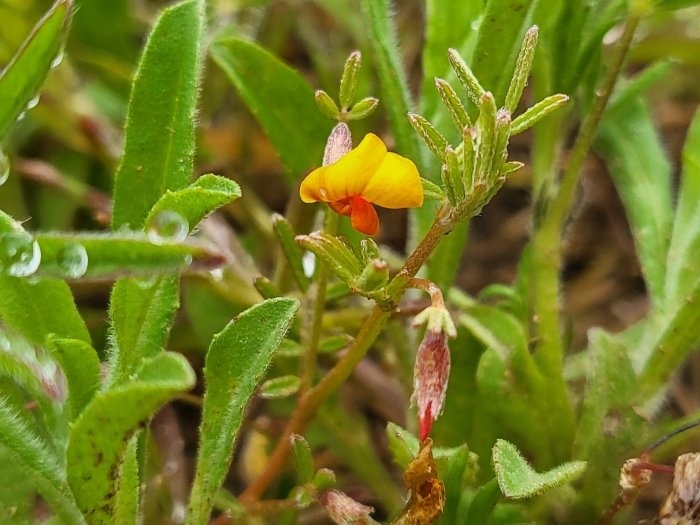Stiff-Haired Lotus
(Acmispon strigosus)
Stiff-Haired Lotus (Acmispon strigosus)
/
/

© Nicole
CC BY 4.0
Image By:
© Nicole
Recorded By:
Copyright:
CC BY 4.0
Copyright Notice:
Photo by: © Nicole | License Type: CC BY 4.0 | License URL: http://creativecommons.org/licenses/by/4.0/ | Uploader: pineten | Publisher: iNaturalist |
























Estimated Native Range
Summary
Acmispon strigosus, commonly known as stiff-haired lotus or strigose bird’s-foot trefoil, is a prostrate annual herb native to chaparral, coastal sage scrub, and open woodlands in the southwestern United States and northern Mexico. It is well-adapted to disturbed areas, often colonizing open spaces after fires or human activities. This species typically grows to a height of 4-16 inches (10-40 cm) with slender, sprawling branches. The leaves are pinnately compound with small leaflets, each 1/2" to 1" long, varying in hairiness from roughly hairy to nearly hairless.
The stiff-haired lotus blooms from late spring to early summer, producing showy yellow to orange or red pea-like flowers, each about 0.5 inches across, which are attractive to pollinators. It is followed by legume pods that are 0.5-1 inch long. In cultivation, Acmispon strigosus is valued for its drought tolerance and ability to thrive in poor soils, making it suitable for xeriscaping and restoration projects. It prefers full sun to part shade and requires minimal water once established. While it is not commonly used in ornamental gardening, it can serve as a ground cover or be integrated into wildflower meadows. Potential problems include overwatering, which can lead to root rot, and competition with more aggressive plants.CC BY-SA 4.0
The stiff-haired lotus blooms from late spring to early summer, producing showy yellow to orange or red pea-like flowers, each about 0.5 inches across, which are attractive to pollinators. It is followed by legume pods that are 0.5-1 inch long. In cultivation, Acmispon strigosus is valued for its drought tolerance and ability to thrive in poor soils, making it suitable for xeriscaping and restoration projects. It prefers full sun to part shade and requires minimal water once established. While it is not commonly used in ornamental gardening, it can serve as a ground cover or be integrated into wildflower meadows. Potential problems include overwatering, which can lead to root rot, and competition with more aggressive plants.CC BY-SA 4.0
Plant Description
- Plant Type: Herb
- Height: 0.5-1.5 feet
- Width: 0.5-1.5 feet
- Growth Rate: Moderate
- Flower Color: Yellow
- Flowering Season: Spring, Summer
- Leaf Retention:
Growth Requirements
- Sun: Full Sun, Part Shade
- Water: Low
- Drainage: Medium, Fast
Common Uses
Drought Tolerant, Low Maintenance
Natural Habitat
Native to chaparral, coastal sage scrub, and open woodlands in the southwestern United States and northern Mexico
Other Names
Common Names: Strigose Bird’s-foot Trefoil
Scientific Names: , Acmispon strigosus, Acmispon strigosus, Acmispon strigosus var. hirtellus, Anisolotus hirtellus, Anisolotus nudiflorus, Anisolotus rubellus, Anisolotus strigosus, Hosackia hirtella, Hosackia hirtellus
GBIF Accepted Name: